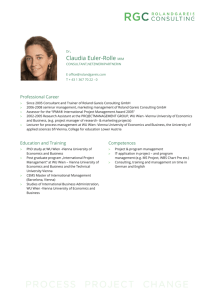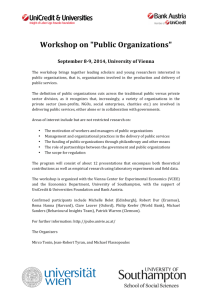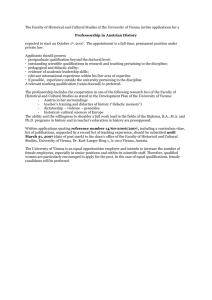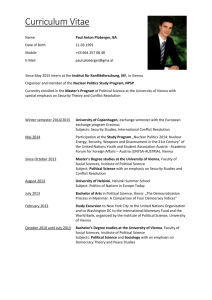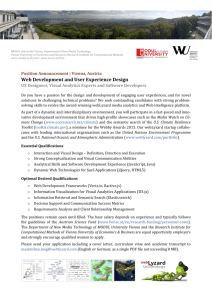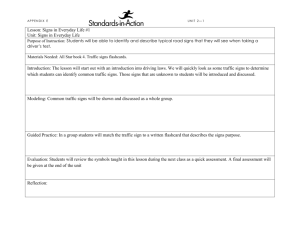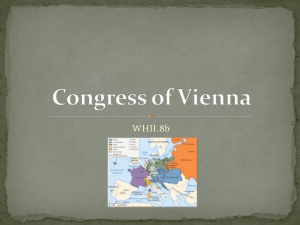Doris Damyanoviç: Fair Shared City
advertisement
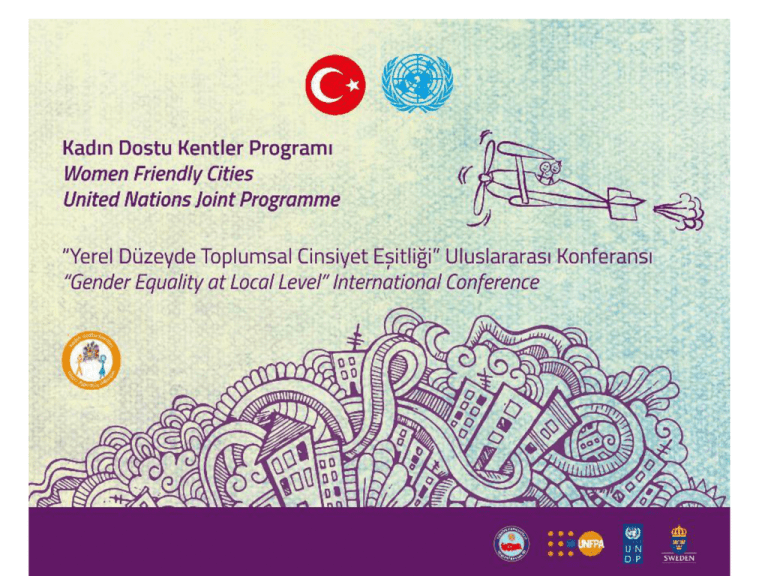
Fair-Shared City Gender-sensitive Approach in Urban Planning in Vienna Ass. Prof. Dr. Doris Damyanovic Institute of Landscape Planning, Department of Landscape, Spatial and Infrastructures Sciences, BOKU, Vienna Conference Women Friendly Cities Ankara 10-11th of June, Turkey Fair-shared Cities Concepts to the right to a gendered city (Fenster, T. 2005, Dufaux et al. 2008, Fainstein 2010)) • Inhabitants have the right to “full and complete use” of urban space in their everyday lives •Inhabitants have the right to a fair participation in decision-making processes What is necessary to turn a City (e.g. Vienna) into a fair-shared City? Facts of Vienna • Capital of Austria • 1.7 million inhabitants - 23 districts • increasing population after decades of stagnation • High percentage of historical districts • „Green city“, but lack of open space in districts close to the city center • Intensive public transport system (Modal Split, 39% public transport, 27% car traffic) • 80% of new housing projects are subsidised Vienna becomes a fair-shared City • • • • 20 years of experience 60 Pilot projects Advising experts Raising awareness of a higher number of planners, across all departments ➔ Developing a manual with the a networked autonomous discourse apporach (Böcher & Krott 2007) DAMYANOVIC, D.; REINWALD, F. and WEIKMANN, A. (2013), Gender Mainstreaming in Urban Planning and Urban Development. Wien: Werkstattbericht der Stadt Wien. 20 Years Women´s Interests in the Field of Planning • 1991: exhibition „Who does public space belong to – Women´s Everyday Life in the City “ • 1992: Women´s Office • 1998: Co-Ordination Office for Planning and Construction geared to the Requirements of Daily Life and the Specific Needs of Women, Co-Ordination Office puts focus on Gender Mainstreaming • 2010: Restructuring of the Executive Office Group for Urban Planning, Development and Construction, Dissolution of the Coordination Office, Gender experts in the units: 1. Urban Planning Group, 2. Building Construction Group, 3. Public Works Group Planning for a fair-shared City The underlying principles of the development of the manual „Gender Mainstreaming in Urban Planning and Development“: ➔Process-orientated approach Gender-sensitive perspective in all stages of the urban planning process ➔Inter- and transdisciplinary discourse Planning for different life phases - Everyday Life Perspective Everyday Life Perspective •The intensity of interrelations between persons und their local environments various according to life phases • Different user profiles give the visibility to the varying everyday realities of people in the urban context •The description of various groups permit deriving user profiles for planning and project development User and user profiles •Children aged 6 or under •Children aged 6 to 12 years •Young people aged 13 to 17 years •Working-age women and men •Elderly or very aged women and men •Women and men with special needs Gender distribution of paid and unpaid work Households with children Purpose of trips taken Female/Male distribution of persons 75+ Planning for different life phases focuses on locally dependent groups: •Young people until 12 years •People who have to combine family work and wage work •Elder people - 75+ Gender mainstreaming as a comprehensive planning strategy Formulating indicators for two main topics in urban planning: City structures and Quality of living & Open space and Mobility Check-questions Quality criteria Comments and explanation Everyday route check to evaluate the suitability of an master plan (f. e. Aspern) Combination paid work and familiy duties Paid work Gender-Sensitive Landuse Planning • Large-scale urban development projects • Significant upgrading of individual sites in developed areas • Structural additions or changes • Small-scale adaptation combined with area assessment and structureimproving measures Gender-Sensitive Landuse Planning • High-quality architectural und utilisation structures – (special designated areas special ground floor use) • Access und circulation quality and public space (parks and playground) • Social infrastructure (kindgarden, schools) Gender Sensitive Park Design Criteria • Spatial structure (f. e. networking of open spaces, differentiated spatial concept) • Subjective feeling of safety/security • Activity range of girls • Recommended frame conditions Gender-Sensitive Housing Criteria • Size and Layout of Dwellings (f. e. attractive orientation, minimum size of rooms, natural lighting in kitchen) • Internal communication routes (f. e. manageable size of residential community) • Shared space/Communal rooms (f. e. attractive room, storage room for bikes and prams, attractive laundry room) • Open Spaces (private spaces, attractive space for toddler playground) Concept flat designed for different life phases Gender-Sensitive Housing Objectives • Facilitating housework and family task • Promoting good-neighbourly contacts • Creating a housing environment where residents can move safely even at night • Providing the widest possible range of different flat layouts Gender-Sensitive Housing Objectives • Economical and flexible layouts offering options for women with lower incomes • Attractive range of private and semi-public open spaces • Good range of social infrastructure facilities • Promoting the work of women planners Conclusions ➔ Gender Mainstreaming is an political instrument to implement the concept of a fair-shared city/just city/women friendly city in concepts, policies and planning strategies ➔ Vienna shows us that the planning approach of equity planning to implement the fair-shared city/women friendly concept is successful References DAMYANOVIC, D.; REINWALD, F. and WEIKMANN, A. (2013), Gender Mainstreaming in Urban Planning and Urban Development. Wien: Werkstattbericht der Stadt Wien. https://www.wien.gv.at/.../studien/pdf/b008358.pdf Dufaux, F., Lehmann-Frisch, S., Moreau, S., Gervais-Labony, P. (Eds.), 2008. Birth announcement. Paris: Self-published. Fainstein, S., 2010. Just City. Itaca: Cornwall Press. Fenster, T., 2005. The right to the Gendered City: Different formations of belonging in everyday life. Journal of Gender Studies, Vol. 14, No. 3 November: 217-231. Contact Ass. Prof. Dr. Doris Damyanovic Institute of Landscape Planning Department of Landscape, Spatial and Infrastructure Sciences University of Natural Resources and Life Sciences, Vienna Peter-Jordan Strasse 65 1180 Vienna phone.: 0043/1/47654-7255 fax.: 0043/1/47654-7259 mobil: 0043/664/21 31 737 homepage: www.rali.boku.ac.at/ilap.html http://www.rali.boku.ac.at/ilap/gdus-network/ http://www.genderste.eu/ http://aktive-jugend.boku.ac.at genderSTE Science, Technology, Environment A COST TARGETED POLICY-DRIVEN NETWORK Chair INÉS SÁNCHEZ DE MADARIAGA Ministry of Economy and Competitiveness, Spain Vice-Chair MARCELA LINCOVA Czech Academy of Sciences, Czech Republic genderSTE COST ACTION TN 1201 Start date: 28/11/2012 End date: 27/11/2016 A COST TARGETED POLICY-DRIVEN NETWORK WHO AND WHAT IS genderSTE ? • genderSTE is a network of policy makers and experts committed to promoting a fairer representation of women and better integration of gender analysis in research and innovation. • We disseminate state of the art know-how on structural change of institutions and on methods for gendered analysis in research. • We aim at advancing the state of knowledge in the specific fields of: cities, transport, energy, climate and industrial innovation. • Our members represent government bodies, research organizations, universities, non-profits, and private companies from 40 countries, in Europe and beyond, as well as international organizations. EDITH STEIN TRAINING SCHOOL Engendering Research about Cities, Transport, Energy & Climate Change 2015, Istanbul, 2nd-6th of November Target group: young researcher www.genderSTE.eu Design: Sofia Morgado, April 2014
